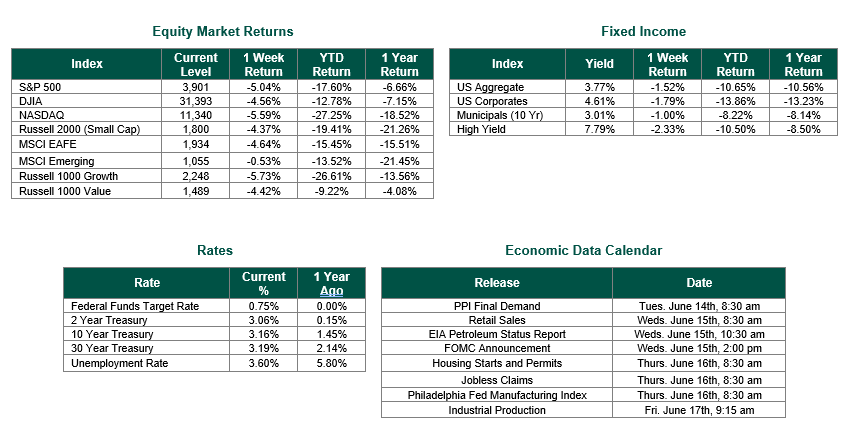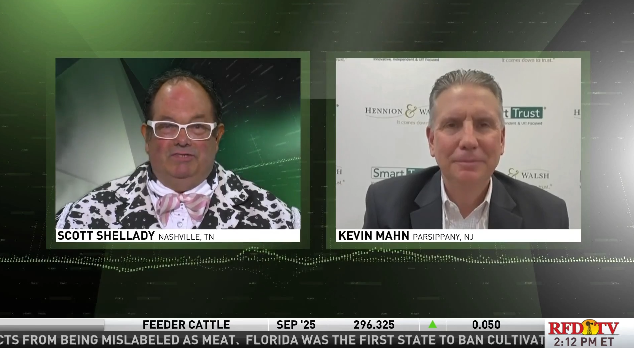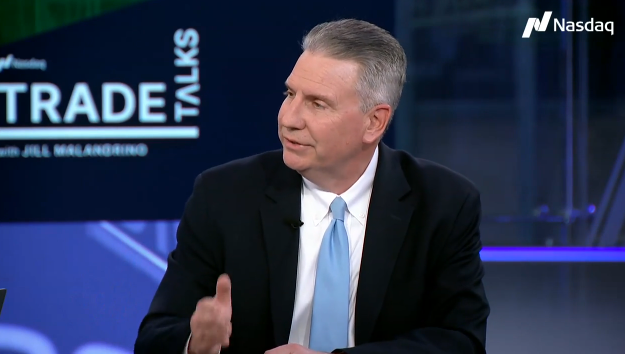
Last Week’s Markets in Review: Markets Get Burnt by Hot Inflation

Global equity markets finished lower for the week. In the U.S., the S&P 500 Index closed the week at a level of 3,901, representing a decline of 5.04%, while the Russell Midcap Index moved 5.65% lower last week. Meanwhile, the Russell 2000 Index, a measure of the Nation’s smallest publicly traded firms, returned -4.37% over the week. International equity performance was also lower, with developed and emerging markets returning -4.64% and -0.53%, respectively. Finally, the 10-year U.S. Treasury yield increased, closing the week at 3.16%.
Market participants entered the past week with a high degree of uncertainty, and an expectation of more volatility, in advance of the highly anticipated Consumer Price Index (CPI) report that would be released early Friday morning. The week opened on a positive note as Monday trading exhibited optimistic returns from a bounce back from a 120-basis point drop in the S&P 500 index the week prior. Tuesday’s trading was even more encouraging as the index rose 95 basis points on the heels of international trade data that showed a $20 billion reduction in the trade deficit.
Unfortunately, the positive moves within markets to start the week were short-lived. On Wednesday, the S&P 500 index traded down 1.08% as gasoline inventories decreased weekly by 800,000 barrels, indicating further supply-side pressure in an already constrained market. On Thursday, markets opened down just 0.34% but would later crumble in the final hours of trading to -2.34% in anticipation of Friday’s inflation report.
The markets’ reaction late Thursday became justified as what most market participants feared the most came to fruition early Friday morning. The Bureau of Labor Statistics (BLS) delivered a major blow to markets as May year-over-year inflation came in at 8.6%, significantly above consensus expectations of 8.2% and marking the highest reading since 1981. Even after Thursday’s sell-off, markets did not take kindly to the news as the week would finish with the S&P 500 down 2.91% on Friday and -5.04% for the week.
Hotter-than-expected inflation led investors to believe that it is becoming more likely that the Federal Reserve will have to be more aggressive in its interest rate hiking to combat these near-record level prices. As a result, equity markets were not the only security instrument to squander at the news, as the 2-year U.S. Treasury Bond jumped to over 3%, the first time that this has occurred since 2008 during the great financial crisis. To put these rates into perspective, this time last year, the 30-year U.S. Treasury was trading at a yield of 2.30%, while the 2-year U.S. Treasury yielded just 0.16%.
Highlights of the May CPI release include the following:
• CPI increased by 8.6% on a year-over-year basis
• Core inflation, which excludes food and energy, rose 6% on a year-over-year basis
• Food, gasoline, and energy were major contributors to the increase in the index with 10.1%, 106.7%, and 34.6% year-over-year gains, respectively.
• Although average hourly earnings rose 0.3% during the month, real earnings (after accounting for inflation) were down 3% on a year-over-year basis.
Investors should consider all the information discussed within this market update and many other factors. However, with so much data and so little time to digest it all, we encourage investors to work with experienced financial professionals to help process all this information to build and manage the asset allocations within their portfolios consistent with their objectives, timeframe, and risk tolerance.
Best wishes for the week ahead!
CPI data was sourced from the Bureau of Labor Statistics on 6/10/22. Equity Market and Fixed Income returns are from Bloomberg as of 6/10/22. Rates and Economic Calendar Data from Bloomberg as of 6/10/22. The MSCI EAFE Index measures international developed markets, emerging markets are measured by the MSCI EM Index, and U.S. Large Caps are defined by the S&P 500 Index. Sector performance is measured using the GICS methodology.
Disclosures: Past performance does not guarantee future results. We have taken this information from sources that we believe to be reliable and accurate. Hennion and Walsh cannot guarantee the accuracy of said information and cannot be held liable. You cannot invest directly in an index. Diversification can help mitigate the risk and volatility in your portfolio but does not ensure a profit or guarantee against a loss.
Investing in commodities is not suitable for all investors. Exposure to the commodities markets may subject an investment to greater share price volatility than an investment in traditional equity or debt securities. Investments in commodities may be affected by changes in overall market movements, commodity index volatility, changes in interest rates or factors affecting a particular industry or commodity.
Products that invest in commodities may employ more complex strategies which may expose investors to additional risks.
Investing in fixed income securities involves certain risks such as market risk if sold prior to maturity and credit risk, especially if investing in high yield bonds, which have lower ratings and are subject to greater volatility. All fixed income investments may be worth less than the original cost upon redemption or maturity. Bond Prices fluctuate inversely to changes in interest rates. Therefore, a general rise in interest rates can result in the decline of the value of your investment.
Definitions
MSCI- EAFE: The Morgan Stanley Capital International Europe, Australasia and Far East Index, a free float-adjusted market capitalization index that is designed to measure developed-market equity performance, excluding the United States and Canada.
MSCI-Emerging Markets: The Morgan Stanley Capital International Emerging Market Index, is a free float-adjusted market capitalization index that is designed to measure the performance of global emerging markets of about 25 emerging economies.
Russell 3000: The Russell 3000 measures the performance of the 3000 largest US companies based on total market capitalization and represents about 98% of the investible US Equity market.
ML BOFA US Corp Mstr [Merill Lynch US Corporate Master]: The Merrill Lynch Corporate Master Market Index is a statistical composite tracking the performance of the entire US corporate bond market over time.
ML Muni Master [Merill Lynch US Corporate Master]: The Merrill Lynch Municipal Bond Master Index is a broad measure of the municipal fixed income market.
Investors cannot directly purchase any index.
LIBOR, London Interbank Offered Rate, is the rate of interest at which banks offer to lend money to one another in the wholesale money markets in London.
The Dow Jones Industrial Average is an unweighted index of 30 “blue-chip” industrial U.S. stocks.
The S&P Midcap 400 Index is a capitalization-weighted index measuring the performance of the mid-range sector of the U.S. stock market and represents approximately 7% of the total market value of U.S. equities. Companies in the Index fall between S&P 500 Index and the S&P SmallCap 600 Index in size: between $1-4 billion.
DJ Equity REIT Index represents all publicly traded real estate investment trusts in the Dow Jones U.S. stock universe classified as Equity REITs according to the S&P Dow Jones Indices REIT Industry Classification Hierarchy. These companies are REITs that primarily own and operate income-producing real estate.



